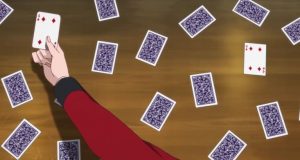How many players play?
This card game can be played solo to “exercise your brain” or with any number of friends, competing to see who has the best memory.
Materials needed for the game
The game is played with a standard 52-card deck. The cards are laid out in 4 columns of 13. If playing with jokers, arrange 6 columns of 9 cards. To make the game last a bit longer, you can play with two decks of cards.
Objective of the game
Flip over 2 identical cards and collect as many cards as possible.
Best online casinos offering games:
How to play the Memory card game?
Before the game, agree on the rules – whether you will be looking for two identical cards of the same rank (e.g., 2 kings), the same color (e.g., red), or the same suit (e.g., clubs).
For example, the simplest, traditional version of “Memory” is played. The cards are shuffled and laid face down on the table. The game is played clockwise.
The first player flips over two cards. If the flipped cards do not match, they are turned back over and the turn passes to the player sitting to their left.
If the cards match (e.g., flipping over the queen of hearts and the queen of spades, the five of clubs or the five of diamonds), they keep them and continue flipping two cards. One player continues flipping cards until they make a mistake, and then the turn goes to the next player.
Memory game strategy
As more cards are gradually flipped over, players with better visual memory will have a higher chance of winning.
The problem occurs when you think you know where both cards are, but after flipping the first one, you often forget where the second identical card is.
So a better strategy would be to flip a card you are unsure about and then try to find the second one.
Or imagine there are t (t – unknown cards) and n (n – known cards) left on the table.
If a player flips an unknown – t – card and they remember that such a card is not among the known – n – cards, it is better to choose to flip a known – n – card as the second one.
In this case, you will reduce your opponents' chances of winning by giving them less information about the unknown cards.
Of course, you can always take a risk and hope that luck smiles on you and you flip the cards correctly right away!
Who won?
The player who flips the most identical cards wins the “Memory” card game.
So, focus your thoughts, concentrate, don't “count crows,” and you will quickly become the winner!
The game can even be an educational tool to improve children's memory and logical thinking.
Different variations of the “Memory” game
To make the game more interesting, many variations have been invented:
One turn. If a player finds a pair of cards on the first try, they do not get a second turn.
Zebra. Pairs of cards can be made from cards of the same rank but different colors – red and black – for example, the ten of hearts and the ten of spades.
Two decks. For a longer game, arrange two decks of 52 cards. Lay them out in 8×12 or 9×12 if playing with jokers.
Pairs must be identical in both rank and suit, so if you flip a queen of clubs in one pile, you must find the same queen of clubs in the other “deck.”
Two-deck duel. This variation is played by an even number of players. For example, two players each lay out a standard deck of cards on the table. Arrange 4 columns of 13 cards. Interestingly, players cannot reach each other's cards.
The first player starts and flips a card from their side. Then their game partner flips a card from their side. If the cards match, they are taken from the table; if not, they are turned back over. The game proceeds in roles – “question” and the other player's “answer.”
Checkers. This is a slightly easier version of Two-deck. Two decks of cards with different colored/patterned backs are used for the game.
The cards are laid out in a “checkers” pattern so that adjacent cards are of different colors. This way, the game becomes easier, and fewer moves are needed to find matching cards.
Fancy. In this variation, the cards are laid out not in a square but in a different, irregular shape, such as a triangle, diamond, oval, square, or circle.
This way, the game becomes more challenging and gains new colors, as it becomes “different.”
Spaghetti. To make the game even harder and more interesting, the cards can be laid out not on the table but throughout the room or even in the yard (if it's not windy).
In this case, not only your brain but also your body will be active!

This game is not limited to just playing with cards. Many educational, same-principle – find two identical pictures – board and computer games have already been created.
In some computer games, the cards or other pictures change places, confusing the player, making it even more challenging to find matching illustrations.
Find more card games here.





